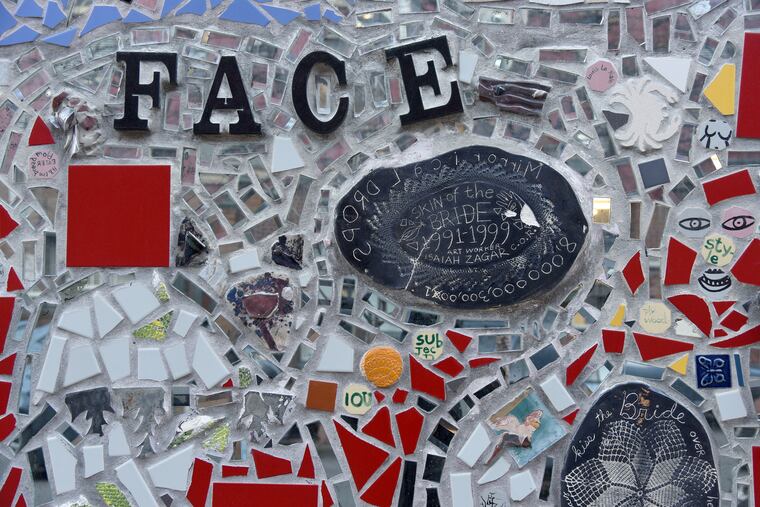Petition for Painted Bride historic designation rejected; demolition of Zagar murals now possible
The Philadelphia Historical Commission, in a 5-4 vote Friday, rejected a bid to protect the building enwrapped with Zagar's detailed and fanciful mosaics.

It could be the end for the Painted Bride Art Center's building with its colorful dress of Isaiah Zagar murals that have marked Old City as an arts district and the Bride as a Philadelphia arts pioneer for nearly 30 years.
The Philadelphia Historical Commission on Friday rejected an application to historically certify the landmark building at 230 Vine St., following lengthy testimony from the public and advocates on both sides of the issue.
Approval of the designation would have placed the building and all proposed changes to it — including demolition — under the historical commission's protective jurisdiction.
Those opposing the historic designation — largely the Bride and its supporters — argued that certifying the building would significantly reduce the value of the property on the still-hot real estate market.
And that would cripple the Bride's efforts to sell the building and create an endowment, which would support the organization's plans to move nimbly, without the burdens of a building, to bring art and performance to neighborhoods all over the city.
Harriet Rubenstein, a Bride board member, told the commission that "historic designation is not appropriate" and would "make the Painted Bride a prisoner of its own building."
Emily Smith, executive director of Philadelphia's Magic Gardens, a showcase for Zagar's distinctive mosaics on South Street and the organization that sought historic designation for the Bride, told the commission that the "Painted Bride is the crown jewel of cultural Philadelphia."
"The building," Smith said, "has become known as [Zagar's] masterpiece."
>> READ MORE: Magic Gardens takes action to save Isaiah Zagar's Painted Bride mosaics: 'one of his masterpieces'
After three hours, the commission voted 5-4 to reject designation, with chairman Robert Thomas abstaining at the last moment.
The initial voice vote was 5 to 5. Thomas, commenting to a colleague that a tie vote "creates problems," then called for the commissioners to be polled individually. Thomas abstained from the second vote. He could not be immediately reached after the meeting for comment.
Zagar, who attended the meeting, said the "no" vote would not be the final word. "They should have let me be the deciding vote," he said.
Smith, who prepared the application, sat in the back of the room following the vote, nearly at a loss for words. "I'm a little shocked," she said. "I do believe we made a very good case based on the [historic designation] criteria."
Paul Steinke, executive director of the Preservation Alliance of Greater Philadelphia, said a close vote had been anticipated. "I don't see a flaw in the procedure," Steinke said. "There was a duly taken vote, 5 to 4 with one abstention, after three hours of public discussion."
‘Hardship arguments’
Steinke noted that the Bride pushed the commission on what are called "hardship arguments" — that historic designation would undermine Philadelphia's oldest alternative arts organization's financial and artistic future by significantly reducing the market value of its building.
Rejection of the application means that developers can acquire the property and proceed with whatever they wish, subject only to zoning.
Sometimes passionate testimony from both sides marked the packed hearing. Advocates opposed to designation spoke of the Bride's current plans to shed the building and serve all neighborhoods of the city.
"The Painted Bride is much more than a building," said Laurel Raczka, executive director of the Bride for 19 years.
She argued that the organization, which began in an old bridal shop on South Street in 1969 and moved to its Vine Street location in 1982, has never been wedded to permanence. Zagar began his work on the mosaics in 1991, eventually sheathing the entire building over the course of several years.
Raczka said that most of the city's neighborhoods lack funding for the arts and lack arts organizations. Filling that void is now the Bride's mission, she said.
"Access [to the arts] is vital," Raczka said.
Poet Ursula Rucker, in testimony that verged into spoken word, told the commission that "the Painted Bride Art Center has always been a beacon of art."
But, she added, "Do we want the Painted Bride to be a mausoleum … of what used to be?"
‘National treasure’
Kathleen Foster, curator of American art at the Philadelphia Museum of Art, said that "the Painted Bride murals are a great work of art deserving of preservation" for future generations. "We should call Isaiah Zagar a Philadelphia national treasure," she said.
There are no outstanding bids for the Bride building at the moment. Raczka said that potential buyers were awaiting the outcome of the historical commission meeting.
Lantern Theater Company, a growing theater operation bursting at the seams of its current home in St. Stephen's Theater, at 10th and Ludlow Streets, made a serious bid for the Bride building in recent days.
The offer, which would have provided the Bride with significant rental income, was rejected.
Charles McMahon, Lantern's artistic director, told the commission that the desire for theater in Philadelphia is growing but the number of venues is not.
"This is a great venue," McMahon told the commission. "We need the space. We need the venues. We need the bones and the bodies … to support the artists and the artists of tomorrow."